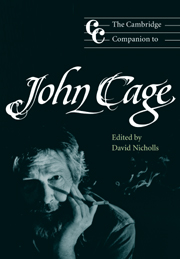4 - Music I: to the late 1940s
from Part II - Sounds, words, images
Published online by Cambridge University Press: 28 September 2011
Summary
John Cage's earliest exposures to music were rather limited, being, for the most part, confined to late nineteenth-century repertoire. Cage began studying the piano at the age of eight, later taking lessons with his Aunt Phoebe James and then with Fannie Charles Dillon, a composer interested in the musical potential of birdsong (Cage 1948a, pp. 27–28). While in Paris in 1930, a concert of works by Stravinsky and Scriabin by pianist John Kirkpatrick inspired Cage's interest in modern music. He enthusiastically explored this new repertoire on the piano and composed several works derived from mathematical calculations, which he later described as having “no sensual appeal and no expressive power” (Cage 1948a, p. 29).
On returning to Los Angeles in the fall of 1931, Cage continued composing, this time through improvisation at the piano. In his Three Songs (1933) with texts by Gertrude Stein, the music closely follows the text. The first song, “Twenty Years After,” consists almost entirely of two motives (D–E–G–A–A and G#–F#–D#) repeated with almost the same rhythms in both the piano and the voice part. These repetitions mirror Stein's poetic style; they are, as the composer later explained, “transcriptions from a repetitive language to repetitive music” (Cage 1989, p. 238). They also prefigure Cage's later predilection for repeated pitch/rhythmic motives in both his twelve-tone and his percussion music. Their texture is sparse. For example, the second song, “Is it as it was,” contains only the voice melody accompanied by a single line in the piano.
- Type
- Chapter
- Information
- The Cambridge Companion to John Cage , pp. 61 - 84Publisher: Cambridge University PressPrint publication year: 2002
- 9
- Cited by



